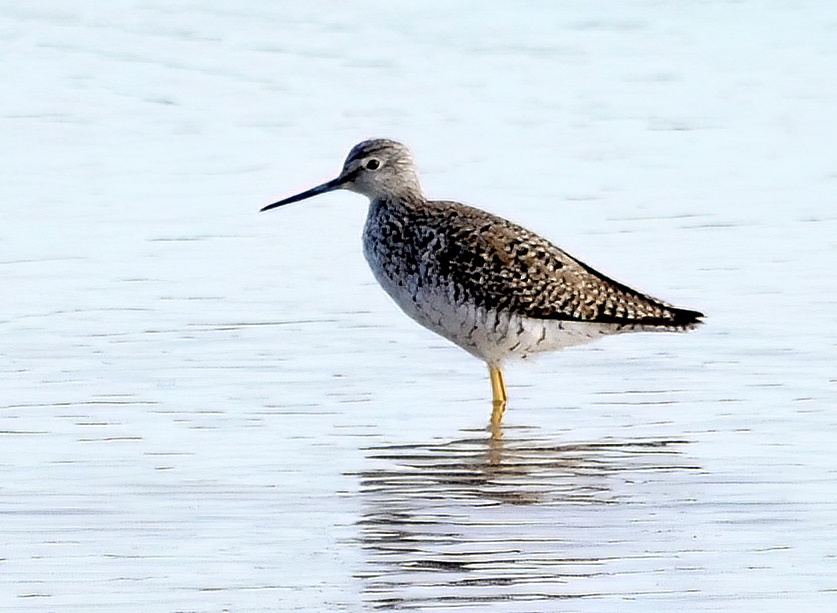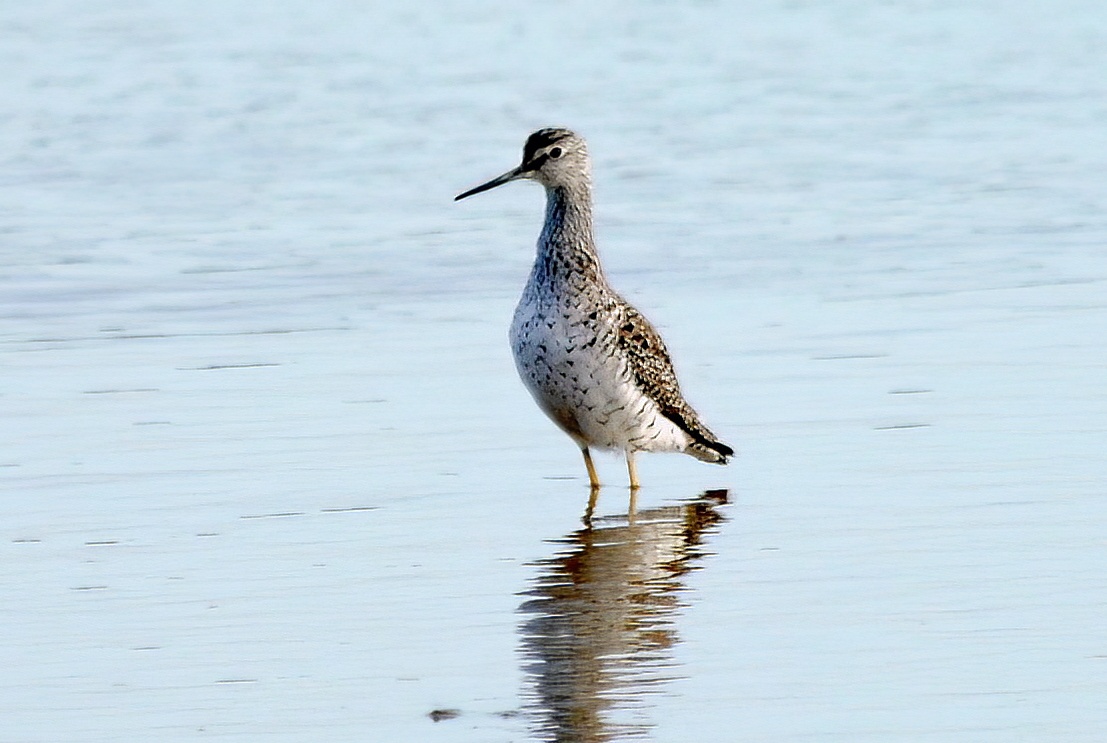Greater Yellowlegs Tringa melanoleuca


One of the rarer North American waders to occur in Britain, the first county record wasn’t until April 2007 at Freiston Shore then in May 2007 it turned up at Gibraltar Point, presumably having been out of sight somewhere on The Wash between times. Amazingly, a second was seen at Baston GP in late September 2007 and was considered to have been a different bird – it was quite short billed compared to the bird at Gibraltar Point, which was particularly long billed, and it turned up at the height of autumn wader passage. It came in from the north-west, stopped for 20 mins and flew off south and was in Hampshire the following day.
Identifying Greater Yellowlegs has been well-covered in the literature but can still be tricky on lone individuals where the differences in size and structure are more difficult to evaluate - the bird at Freiston was initially identified as a Lesser Yellowlegs, but had fortunately been photographed when it's cirrect identity was confirmed. Identification of lone individuals can be surprisingly tricky where crucial differences in size and structure are more difficult to evaluate. In breeding plumage, Greater shows heavier black barring on the underparts than Lesser Yellowlegs, T. flavipes, and sometimes barring extending across the belly, something admirably described in the finders account at Gibraltar Point in LBCRS 2003-2007. Between 1950-2018 there were 27 British records although in some years the mobility of the bird(s) involved made assessment difficult; averages about one every two years.
There have been 29 UK records up to 2020, averaging one every 1-2 years. May is the main month of first arrivals. Autumn records have been widespread with birds turning up in all months between July and November.
| Site | First date | Last date | Count | Notes |
| Freiston Shore | 09/04/2007 | 1 | ||
| Freiston Shore | 19/05/2007 | 1 | Same bird | |
| Gibraltar Point NNR | 30/05/2007 | 31/05/2007 | 1 | Same bird |
| Baston and Langtoft GP | 25/09/2007 | 1 |
Finder’s report: Greater Yellowlegs at Gibraltar Point, May 30th, 2007, first county record.
compiled by K. M. Wilson and J. P. Shaughnessy.
Note: This account is based on that which appeared in the Lincolnshire Rare & Scarce Bird Report 2003-2007. The bird was first seen at Freiston Shore and recorded as a Lesser Yellowlegs and despite its long stay it stayed out of reach on The Wash for most of that time and only appeared in front of bird hides on reserves on four dates. Fortunately, it was correctly identified in late May at Gibraltar Point before flying off late on May 31st towards The Wash never to be seen again. It was the 60th species of wader to be identified at the time.
Circumstances
Early on May 30th JPS arrived at the Tennyson’s Sands hide and soon found alongside a Greenshank a second, very different Tringa on a small island about 150m from the hide. It appeared even larger with a less attenuated rear end, longer yellow legs, and a long, fine straight bill. The underpart patterning was bold and included coarse vertical bars along the flank. JPS had experience of all of the Tringa group except what seemed to be this one: Greater Yellowlegs. Disbelief and caution took over. He phoned KMW just saying that he had an odd wader about the size of a Greenshank with yellow legs, and what did Greater Yellowlegs look like? Shortly after KMW’s arrival the bird awoke and showed off its bill allowing KMW to obtain some record video footage of the bird. Ed Mackrill (EJM), contacted by KMW, then arrived and took just a few seconds to concur that it was a yellowlegs, and that it must be a Greater. The three observers then assessed the identification features of this bird.
It was presumed that the bird was newly arrived when found on May 30th. Indeed, there had been no record even of Greenshank for several days. News of the Greater Yellowlegs was broadcast to Birdlines promptly after identification was confirmed on May 30th. However, shortly afterwards both it and the Greenshank departed south after a 40 minute stay. The news seemed to be treated with some scepticism and attracted very little interest initially. Fortunately, it returned to Tennyson’s Sands that evening from 17.40-17.50 hr; the following morning from 05.45 hr.; and lastly on the evening of May 31st, 17.30-18.00 hr. Its arrival was generally between 30 and 90 minutes in advance of high tide. It did not d=feed much but bathed, preened, and slept. On its second day it had parted company with the greenshank and following the evening visit of 31ts it flew off strongly to the south, calling frequently as it left.
Description
Structure – this bird definitely had the feel of a large Tringa. Its proximity to a Greenshank was extremely fortuitous and provided the most appropriate benchmark for comparison enabling Lesser Yellowlegs to be dismissed from the identification process with confidence. The same site had hosted that species the previous year and had been well studied by the three observers, who noted how slender it appeared and was somewhere between Wood Sandpiper and Redshank in size. The Greater Yellowlegs could appear slightly larger and sturdier than Greenshank. The appearance was doubtless augmented by the length of the straw-yellow legs, and in particular the longer tibia. Furthermore, the bird lacked the thin neck and attenuated rear end of Greenshank. The tertials covered all but the last two or three primary tips, the latter falling just beyond the tail tip, giving a rather blunt-ended appearance for a Tringa (particularly when compared to Lesser Yellowlegs).
Bill – the bill was proportionate to the birds size and structure, being quite long, maybe nearly double the width of the head. It appeared more delicate than that of Greenshank, but rarely gave the impression of being upturned as might be expected. Colour was mostly very dark, fading to dull greyish over the basal 20% or so.
Plumage – overall impression was of a well streaked and spotted wader with an apparent mix of feathers of different age, some tracts of the mantle, scapulars and underparts constituting summer plumage. A strong face pattern was attributable to a broad whitish supra-loral patch and narrow white eye ring. The head and neck (to upper breast) were heavily marked with a complex mix of pale buff and grey-brown streaks giving a mottled effect, some of these amalgamating to create dark blotches. The rest of the underparts were whitish but interrupted on either side by a series of dark vertical and widely spaced bars stretching from the lower breast sides for most of the way along the flanks and most extensive at the mid-flank point where the longest extended halfway to the underbelly. There was also some noticeable dark barring towards the ventral area.
The mantle and scapulars were mostly greyish and partly fringed paler with some darker centred feathers intermixed, these also having pale fringes, spots, or edges. A pattern similar to that on a Greenshank in breeding plumage and which was formed by dark feathers in the rear scapulars. The pale greyish-brown tertials were neatly and continuously patterned with dark transverse bars which bisected the pale fringing to create a spotted effect. The covert tracts appeared similarly spotted on the closed wing. The primaries were very dark. No positive conclusions have been drawn on the age of this individual, whether adult of 2CY.
In flight – prior to take off the open wings revealed a square white rump meeting brownish lower back about level with the trailing edges of the wings. When both waders took off the Greater Yellowlegs still looked larger and more robust than Greenshank. The plain brownish wings and back contrasted sharply with the square white rump. A missing primary was noted on the left wing which could have indicated the start of the standard moult pattern, albeit early.
Call – during the initial observation on the 30th, the bird was not vocal despite occasional calls from the Greenshank. On two other occasions the bird was heard to call in flight, frequently. The call was often repeated and consisted of a Greenshank-like ‘teu-teu-teu’, each syllable in quick succession but distinct. It was slightly lighter in tone lacking the same strength on the ‘t’. JPS thought the call sounded as if the bird was a little out of breath when compared to Greenshank.
Addendum – shortly afterwards evidence came to light that this bird had earlier been present at Freiston Shore where it had been reported as a Lesser Yellowlegs on April 9th and May 19th. Fortunately it had been photographed on both occasions.
References
Hudson, N. and the Rarities Committee (2009). Report on rare birds in Great Britain in 2008. British Birds 102: 528- 601.
Wilson, K and Shaughnessy, J. (2008). Greater Yellowlegs Gibraltar Point May 30th-31st 2007. Lincolnshire Rare & Scarce Bird Report2003-2007: 160-162.
(Account as per new Birds of Lincolnshire (2021), included September 2022)

